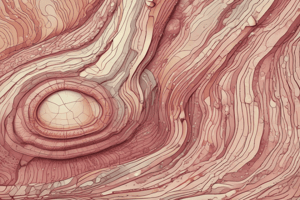Podcast
Questions and Answers
What is the main function of the epidermis layer of the skin?
What is the main function of the epidermis layer of the skin?
- To regulate body temperature
- To provide support and nutrition to skin cells
- To waterproof and protect the skin from infection (correct)
- To store energy in the form of fat
Which skin appendage aids in temperature regulation?
Which skin appendage aids in temperature regulation?
- Sebaceous glands
- Nails
- Sweat glands (correct)
- Hair follicles
What is the main function of the hypodermis layer of the skin?
What is the main function of the hypodermis layer of the skin?
- To provide support and nutrition to skin cells
- To attach the skin to underlying tissues (correct)
- To waterproof and protect the skin from infection
- To regulate body temperature
What is the function of sebaceous glands?
What is the function of sebaceous glands?
What is the main function of the integumentary system?
What is the main function of the integumentary system?
Which of the following is a disorder of the integumentary system?
Which of the following is a disorder of the integumentary system?
What is the function of sweat glands?
What is the function of sweat glands?
What is the function of hair follicles?
What is the function of hair follicles?
Flashcards are hidden until you start studying
Study Notes
Functions of the Integumentary System
- Protects the body from external damage (mechanical, thermal, chemical)
- Regulates body temperature
- Aids in the senses of touch and feel
- Helps to synthesize vitamin D
- Excretes waste products
- Maintains hydration and electrolyte balance
Layers of the Skin
- Epidermis: outermost layer, composed of keratinized stratified squamous epithelium
- Functions: waterproofing, UV protection, barrier against infection
- Dermis: middle layer, composed of connective tissue
- Functions: support, nutrition, and protection of skin cells
- Hypodermis: innermost layer, composed of loose connective tissue
- Functions: attaches skin to underlying tissues, stores energy in the form of fat
Skin Appendages
- Hair follicles: produce hair, which aids in temperature regulation and sensory perception
- Sweat glands: regulate body temperature through evaporation of sweat
- Sebaceous glands: produce sebum, which lubricates and protects the skin
- Nails: protect the sensitive tips of fingers and toes
Accessory Organs
- Hair: aids in temperature regulation and sensory perception
- Nails: protect the sensitive tips of fingers and toes
- Glands: produce sweat and sebum to regulate body temperature and lubricate the skin
Disorders and Diseases of the Integumentary System
- Skin cancer: abnormal growth of skin cells
- Acne: inflammation of sebaceous glands
- Eczema: chronic inflammation of the skin
- Psoriasis: autoimmune disorder causing skin cell buildup
- Burns: damage to skin tissue due to heat, cold, electricity, or chemicals
Functions of the Integumentary System
- Protects body from external damage: mechanical, thermal, and chemical
- Regulates body temperature through sweating and vasodilation
- Aids in senses of touch and feel through sensory receptors
- Helps synthesize vitamin D through UV exposure
- Excretes waste products through sweating
- Maintains hydration and electrolyte balance through sweating and sebaceous glands
Layers of the Skin
- Epidermis: outermost layer, composed of keratinized stratified squamous epithelium
- Provides waterproofing and UV protection
- Acts as a barrier against infection
- Dermis: middle layer, composed of connective tissue
- Provides support and nutrition to skin cells
- Protects skin cells through immune function
- Hypodermis: innermost layer, composed of loose connective tissue
- Attaches skin to underlying tissues
- Stores energy in the form of fat
Skin Appendages
- Hair follicles: produce hair for temperature regulation and sensory perception
- Sweat glands: regulate body temperature through evaporation of sweat
- Sebaceous glands: produce sebum for lubrication and protection of skin
- Nails: protect sensitive tips of fingers and toes
Accessory Organs
- Hair: aids in temperature regulation and sensory perception
- Nails: protect sensitive tips of fingers and toes
- Glands: produce sweat and sebum for temperature regulation and skin lubrication
Disorders and Diseases of the Integumentary System
- Skin cancer: abnormal growth of skin cells
- Acne: inflammation of sebaceous glands causing blackheads and pimples
- Eczema: chronic inflammation of skin causing itching and redness
- Psoriasis: autoimmune disorder causing skin cell buildup and scaly plaques
- Burns: damage to skin tissue due to heat, cold, electricity, or chemicals, classified as first, second, or third degree
Studying That Suits You
Use AI to generate personalized quizzes and flashcards to suit your learning preferences.




